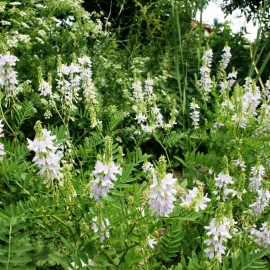


Organic Goat's Rue Seeds (Galega Officinalis)
1.39 €
Known in the old Herbals as Herba ruta caprariae, Galega officinalis was considered medicinally important in the treatment of plague, fevers and infectious diseases but is now considered too toxic for human use.
-
Organic Goat's Rue (Galega Officinalis)
Goat’s rue is originally from the Middle East, but nowadays it grows all over Europe and Asia. This useful and diverse herb has been eagerly spread by humans, who have cultivated it as a fodder, green manure, honey plant, medicinal and ornamental.
It was believed to increase the milk yield of domesticated animals, which is the origin of its scientific name: gale, ‘milk’ and ega ‘to bring, cause’ – so it is the milk-bringer. Since the Middle Ages goat’s rue has been used to treat diabetes as the guanidine it contains lowers blood sugar levels. Species have also been used in fishing: crushed stems are simply thrown into the water and the fish rendered unconscious by the poison are collected from the surface.
In North America there has been a fear that goat’s rue will cross-breed and become a problematic alien, in much the same way that we in Finland have the same fears about garden lupine (Lupinus polyphyllos). Goat’s rue can mainly be found in Finland as a garden ornamental and only occasionally does it spread to the wild.
Oriental Goat’s Rue (Galega orientalis)
The species can be told apart from each other by studying their stipules: on goat’s rue they have a hastate base while on oriental goat’s rue they are entire. Flowers are usualyy darker and pods are hanging (with goat’s rue erect). Oriental gaot’s-rue is classified as a potentially or locally harmful alien species.
Medicinal Uses
Known in the old Herbals as Herba ruta caprariae, Galega officinalis was considered medicinally important in the treatment of plague, fevers and infectious diseases but is now considered too toxic for human use.
Galega officinalis has been known since the Middle Ages for relieving the symptoms of diabetes mellitus. Upon analysis, it turned out to contain compounds related to guanidine, a substance that decreases blood sugar by mechanisms including a decrease in insulin resistance, but were too toxic for human use.
The active ingredient is galegine or isoamylene guanidine. Georges Tanret identified an alkaloid from this plant, galegine, that was less toxic (than guanidine and this was evaluated in unsuccessful clinical trials in patients with diabetes in the 1920s and 1930s.
Other related compounds were being investigated clinically at this time, including biguanide derivatives. This work led ultimately to the discovery of metformin (Glucophage), currently used for the management of diabetes and the older agent phenformin. The study of galegine and related molecules in the first half of the 20th century is regarded as an important milestone in the development of oral antidiabetic pharmacotherapy.
Medieval Europeans first noticed that the plant increased milk production in livestock when eaten. Goat’s rue, sometimes called Holy Hay was first mentioned by dairy farmer Gillet-Damitte in 1873 in a letter to the French Academy in which he described milk production increases in his cows of between 35 to 50 percent when given this herb. Drs. Cerisoli and Millbank subsequently confirmed empirical evidence that goat’s rue is indeed a powerful galactagogue. Goat’s rue is also reputed to increase breast tissue, though how it might do so is not well understood.
Despite the positive reports on cattle, Goat’s rue is considered somewhat controversial due to documented toxicity to sheep and goats who grazed upon it. The plant has proved too toxic for widespread agricultural use, with the potential to induce a build up of excess fluid in the lungs, pleural cavities, or trachea, low blood pressure, paralysis and death.
